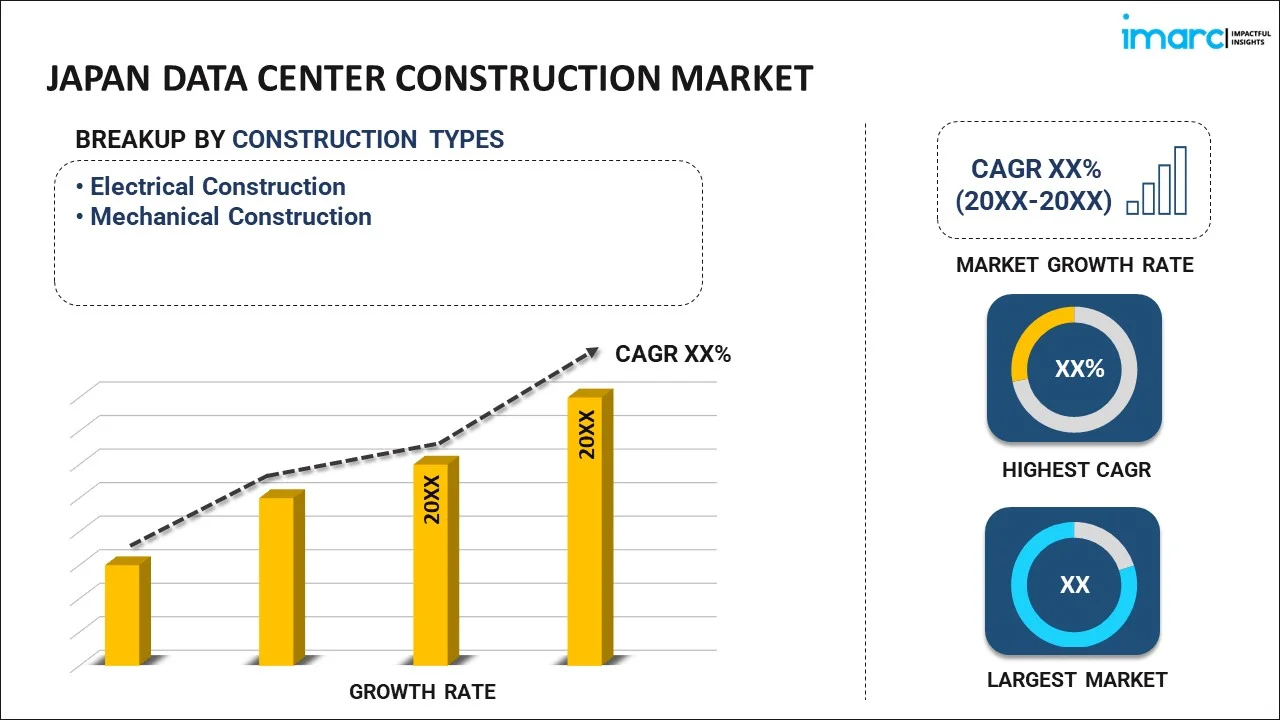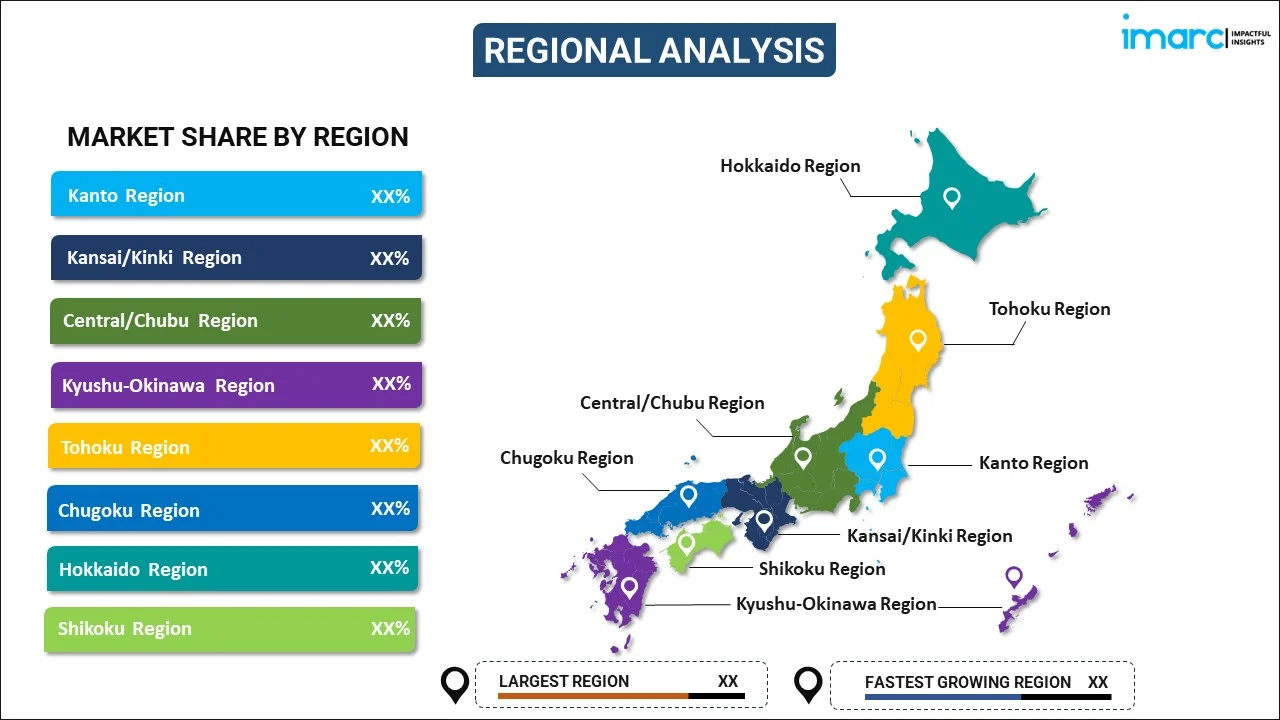
Japan Data Center Construction Market Report by Construction Type (Electrical Construction, Mechanical Construction), Data Center Type (Mid-Size Data Centers, Enterprise Data Centers, Large Data Centers), Tier Standard (Tier I and II, Tier III, Tier IV), Vertical (Public Sector, Oil and Energy, Media and Entertainment, IT and Telecommunication, Banking, Financial Services and Insurance (BFSI), Healthcare, Retail, and Others), and Region 2025-2033
Market Overview:
Japan data center construction market size reached USD 7.1 Billion in 2024. Looking forward, IMARC Group expects the market to reach USD 12.6 Billion by 2033, exhibiting a growth rate (CAGR) of 6.61% during 2025-2033. The market is witnessing significant growth due to several key factors, including the increasing dependence on online shopping and e-commerce platforms, a surge in the adoption of mobile banking applications (m-banking apps), and the expanding utilization of Internet of Things (IoT) devices that generate substantial volumes of data.
|
Report Attribute
|
Key Statistics
|
|---|---|
|
Base Year
|
2024 |
|
Forecast Years
|
2025-2033 |
|
Historical Years
|
2019-2024
|
| Market Size in 2024 | USD 7.1 Billion |
| Market Forecast in 2033 | USD 12.6 Billion |
| Market Growth Rate (2025-2033) | 6.61% |
Data center construction entails the procedures involved in constructing and establishing a facility intended for the accommodation and supervision of an organization's computer systems, networking apparatus, and related components. This process demands meticulous planning and precise execution to guarantee that the facility fulfills particular prerequisites, including security measures, power availability, cooling systems, and redundancy strategies. The primary purpose of data center construction is to facilitate the storage, processing, and efficient management of extensive volumes of data. It results in the creation of a stable, secure, and highly efficient environment where servers and other hardware components can function optimally throughout the entire day.
Japan Data Center Construction Market Trends:
The growth of the data center construction market in Japan is being significantly bolstered by various factors. Firstly, there is a mounting reliance on e-commerce platforms that demand robust data storage and processing capabilities to support their operations effectively. Secondly, there is a rising adoption of data center facilities within the banking, financial services, and insurance (BFSI) sector. These facilities are employed to streamline banking operations and enhance the user experience, contributing to market expansion. Furthermore, the increased use of mobile banking applications (m-banking apps) is being driven by rapid digitization and a substantial dependence on smartphones. This trend is positively impacting the market. Additionally, the growing utilization of Internet of Things (IoT) devices, which generate substantial volumes of data, is creating a favorable market outlook. Moreover, the healthcare industry is increasingly adopting data center construction for the recording and maintenance of patient data, further driving market growth.
The exponential rise in global data consumption, coupled with the proliferation of digital technologies like IoT devices, smartphones, and cloud computing, has increased data storage requirements worldwide. As organizations implement digital transformation strategies, there is a growing need for high-capacity and reliable data centers. This surge in demand has led both public and private organizations to invest in expanding existing data centers or constructing new facilities, which is expected to propel the regional market in the coming years.
Japan Data Center Construction Market Segmentation:
IMARC Group provides an analysis of the key trends in each segment of the market, along with forecasts at the country level for 2025-2033. Our report has categorized the market based on construction type, data center type, tier standards, and vertical.
Construction Type Insights:

- Electrical Construction
- Mechanical Construction
The report has provided a detailed breakup and analysis of the market based on the construction type. This includes electrical construction and mechanical construction.
Data Center Type Insights:
- Mid-Size Data Centers
- Enterprise Data Centers
- Large Data Centers
A detailed breakup and analysis of the market based on the data center type have also been provided in the report. This includes mid-size data centers, enterprise data centers, and large data centers.
Tier Standards Insights:
- Tier I and II
- Tier III
- Tier IV
The report has provided a detailed breakup and analysis of the market based on the tier standards. This includes tier I and II, tier III, and tier IV.
Vertical Insights:
- Public Sector
- Oil and Energy
- Media and Entertainment
- IT and Telecommunication
- Banking, Financial Services and Insurance (BFSI)
- Healthcare
- Retail
- Others
A detailed breakup and analysis of the market based on the vertical have also been provided in the report. This includes public sector, oil and energy, media and entertainment, IT and telecommunication, banking, financial services and insurance (BFSI), healthcare, retail and others.
Regional Insights:

- Kanto Region
- Kansai/Kinki Region
- Central/ Chubu Region
- Kyushu-Okinawa Region
- Tohoku Region
- Chugoku Region
- Hokkaido Region
- Shikoku Region
The report has also provided a comprehensive analysis of all the major regional markets, which include Kanto Region, Kansai/Kinki Region, Central/ Chubu Region, Kyushu-Okinawa Region, Tohoku Region, Chugoku Region, Hokkaido Region, and Shikoku Region.
Competitive Landscape:
The market research report has also provided a comprehensive analysis of the competitive landscape. Competitive analysis such as market structure, key player positioning, top winning strategies, competitive dashboard, and company evaluation quadrant has been covered in the report. Also, detailed profiles of all major companies have been provided.
Japan Data Center Construction Market Report Coverage:
| Report Features | Details |
|---|---|
| Base Year of the Analysis | 2024 |
| Historical Period | 2019-2024 |
| Forecast Period | 2025-2033 |
| Units | Billion USD |
| Scope of the Report | Exploration of Historical and Forecast Trends, Industry Catalysts and Challenges, Segment-Wise Historical and Predictive Market Assessment:
|
| Construction Types Covered | Electrical Construction, Mechanical Construction |
| Data Center Types Covered | Mid-Size Data Centers, Enterprise Data Centers, Large Data Centers |
| Tier Standards Covered | Tier I and II, Tier III, Tier IV |
| Verticals Covered | Public Sector, Oil and Energy, Media and Entertainment, IT and Telecommunication, Banking, Financial Services and Insurance (BFSI), Healthcare, Retail, Others |
| Regions Covered | Kanto Region, Kansai/Kinki Region, Central/ Chubu Region, Kyushu-Okinawa Region, Tohoku Region, Chugoku Region, Hokkaido Region, Shikoku Region |
| Customization Scope | 10% Free Customization |
| Post-Sale Analyst Support | 10-12 Weeks |
| Delivery Format | PDF and Excel through Email (We can also provide the editable version of the report in PPT/Word format on special request) |
Key Questions Answered in This Report:
- How has the Japan data center construction market performed so far and how will it perform in the coming years?
- What has been the impact of COVID-19 on the Japan data center construction market?
- What is the breakup of the Japan data center construction market on the basis of construction type?
- What is the breakup of the Japan data center construction market on the basis of data center type?
- What is the breakup of the Japan data center construction market on the basis of tier standards?
- What is the breakup of the Japan data center construction market on the basis of vertical?
- What are the various stages in the value chain of the Japan data center construction market?
- What are the key driving factors and challenges in the Japan data center construction?
- What is the structure of the Japan data center construction market and who are the key players?
- What is the degree of competition in the Japan data center construction market?
Key Benefits for Stakeholders:
- IMARC’s industry report offers a comprehensive quantitative analysis of various market segments, historical and current market trends, market forecasts, and dynamics of the Japan data center construction market from 2019-2033.
- The research report provides the latest information on the market drivers, challenges, and opportunities in the Japan data center construction market.
- Porter's five forces analysis assist stakeholders in assessing the impact of new entrants, competitive rivalry, supplier power, buyer power, and the threat of substitution. It helps stakeholders to analyze the level of competition within the Japan data center construction industry and its attractiveness.
- Competitive landscape allows stakeholders to understand their competitive environment and provides an insight into the current positions of key players in the market.
Need more help?
- Speak to our experienced analysts for insights on the current market scenarios.
- Include additional segments and countries to customize the report as per your requirement.
- Gain an unparalleled competitive advantage in your domain by understanding how to utilize the report and positively impacting your operations and revenue.
- For further assistance, please connect with our analysts.
 Inquire Before Buying
Inquire Before Buying
 Speak to an Analyst
Speak to an Analyst
 Request Brochure
Request Brochure
 Request Customization
Request Customization




.webp)




.webp)












